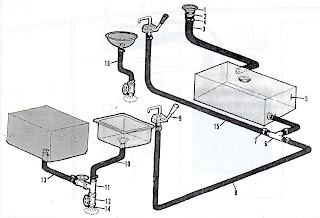“To-Hull”
Fittings vs. Thru-Hull Fittings
Because of a
desire to be more price competitive, before the 1980’s, many boat manufacturers
(sailboat manufacturers included) felt that the hull bottom thickness in
fiberglass boats was sufficiently thick to do away with traditional bronze
thru-hull fittings. The thinking was
that because the bottom of the hull was an inch-and-a-half or more thick that there
was enough structure in the fiberglass to withstand the torque exerted by a
thru-hull valve turning from open to closed and/or back. This thinking persisted with some
manufacturers well into the last half of the 1980’s. Snickerdoodle,
a 1985 Catalina 25, was one of those boats that was manufactured with “to”-
hulls instead of traditional thru-hull fittings.
Here’s how
it worked. Instead of drilling a hole in
the bottom of the boat to accept a traditional bronze thru-hull fitting
including a nut to secure the fitting, a slightly smaller hole was drilled into
which a threaded copper, galvanized iron, or steel pipe was screwed. Some manufacturers left it at that… others
built up a collar of fiberglass slurry to help reinforce the “to” hull. And, in general, this system worked most of
the time even though the “to” hull was certainly not as strong as a traditional
thru-hull fitting.
However,
over time, some of the valves that were screwed into the top of the “to” hull
became difficult to turn from open to closed or the other way around. Complaints about this were often met with a
response of, “Well, you need to lubricate the valve to reduce the torque that
is trying to twist the “to” hull out of the bottom.” What???
How do you lubricate a valve???
Well, there were lots of vague answers - - some even included the suggestion
that a grease fitting zerc could be installed.
Of course,
if the valve became too “stuck”, the twisting on the handle could break the handle
off the valve, break the handle’s stem that turned the stuck ball inside the
valve, or even started to loosen the “to” hull itself. Loosening the “to” hull usually resulted in a
leak. Simply cycling the valve from open to closed and back again would eventually loosen the "to" hull pipe causing a leak. Friends of mine with inboard engines have experienced this last leaky situation after a few years of taking the water intake hose off the thru-hull valve to help get anti-freeze in the engine as part of winterizing. Pulling the hose off the valve nipple loosened the "to" hull pipe.
Toward the
end of the 1980’s new standards began to be implemented which resulted in
nearly all boats being manufactured with traditional thru-hull fittings instead
of the “to” hull pipes. You might want
to take a close look at your boat’s drain fittings. Are they “to” hull pipes or actual thru-hull
fittings. Check for the securing nut on
the inside of your hull that screws onto the inside bottom and snugs the
fitting firmly onto and into the hull.
As I said
earlier, Snickerdoodle was
manufactured with “to” hull pipes. And,
even though I had never had a problem, I decided to replace the “to” hull pipes
with traditional bronze thru-hull fittings.
My plan was to do this the next time I bottom painted the boat the next
time. And, I did just that.
When the
time came, and Snickerdoodle was on a
trailer, I carefully unscrewed the “to” hull pipes. I was surprised that this job was tougher
than I’d expected. Eventually, I
resorted to large vice-grip pliers to give enough twist to unscrew the
pipes. Both pipes came out with the
reinforcing collar (one of which slid off easily). It was easy to see how the pipes had been
screwed in; and then someone had used a grinder to “sand” off the outside so
that the pipe was smooth with the bottom.
Then, the fiberglass slurry was probably squirted around the inside
along the edge between the hull and the pipe.
Now, I had to drill the hole to be just a little bit larger in diameter
(maybe a couple millimeters larger). The
new bronze thru-hull fittings fit into the new holes snugly, and I bedded them
inside and out with 3M 5200. The
securing nut was screwed on and into the 5200 to finish the job.
After the
5200 had set up, I installed the original valves and hoses. After several years with the “new” system, I
can say that there have been no leaks and I have no worries about twisting the
thru-hull fittings out. Ahhh, Peace of
Mind…










